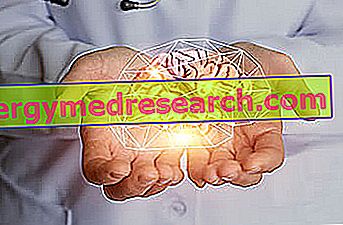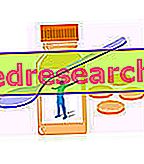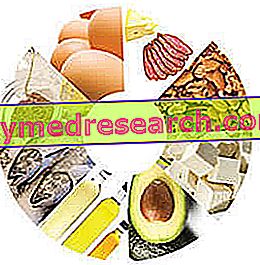The tear (also called distraction) is a very severe muscle injury, affecting the fibrous bundles of one or (rarely) more skeletal muscles.
Represents the most disabling muscle discomfort and also the most difficult to heal. It is characterized by the interruption of muscle continuity and causes a noticeable blood spill (much greater than stretching or elongation).

Muscular tearing is more frequent in the disciplines of: elastic force, maximal strength, explosive force, speed and speed. Some examples are: weight lifting, baseball, soccer, sprinting and jumping competitions.
The most affected districts are the lower limbs (femoral quadriceps, adductors, biceps femoris, triceps sural) and superior (triceps brachialis and deltoid), more rarely the back and the abdominal band.
What to do
- Prevention plays a fundamental role: it is possible to reduce the possibility of muscle tears by exploiting a series of preparatory precautions (see under Prevention). In short:
- General and specific muscle warming.
- Build a suitable training base.
- Dedicate yourself to an activity suited to your athletic condition.
- Treat or take into consideration possible musculo-articular pathologies and imbalances in the motor chain.
- Recognize the symptoms:
- Sharp and sudden pain, proportional to the extent of the damage.
- Total motor disability of the affected muscle.
- Stiff and contracted muscles.
- Edema.
- Significant swelling.
- Sometimes, outcrop of the hematoma.
- Stop not only the sporting activity, but any movement that affects the torn muscle (despite the pain threshold may allow the continuation).
- Make an accurate diagnosis to identify the severity of the distraction. In general, the emergency department is immediately contacted; rarely expects a meeting with the general practitioner. The estimate is made through:
- Palpation and functional verification: it is necessary to check the severity of the damage and to exclude fractures, distortions, etc.
- Imaginography: the most suitable examination is ultrasound, which provides a detail on the vastness and severity of the tear.
- Estimate of the severity level:
- I degree: the damage affects 5% of muscle fibers. It is perceived as a nuisance during contraction and stretching. Determines a loss of strength and limitation of movement. Some confuse him with a serious stretch.
- Level II: the damage affects more than 5% of muscle fibers. It is perceived as a sharp pain that arises during the specific gesture, but sometimes allows to finish the race.
- III degree: the damage corresponds to a laceration of the muscular belly, which reaches 75% of the structure. It causes complete muscular impotence and such pain that you have to sit or lie down.
- Proceed with care. It consists of the RICE protocol (English acronym of the words rest or resting, ice or ice, compression or compression, elevation or elevation):
- Rest: total of at least 1-2 weeks for mild forms, 15-30 days for damages of II degree and beyond for those of III. It is advisable to avoid both sport and any physical activity concerning the specific district.
- Ice: spray or natural to be applied with isolated compresses (plastic bag) and enclosed in a dry woolen cloth.
- Compression: to be carried out during the compress but also useful in the form of a bandage.
- Elevation: if possible, the torn muscle should be positioned above the level of the heart, to facilitate venous return and reduce edema.
- Take anti-inflammatory and myorelaxant drugs after consulting your doctor (see Pharmacological Treatments below).
- Take advantage of specific medical therapies (see under Medical Therapies) taking care not to aggravate the situation.
- Eventually, practice autonomous stretching under the advice of the physiotherapist (the recommendation not to aggravate the damage applies).
- Surgery: it may seem like an "extreme" remedy but sometimes it is necessary.
- Prevention of relapses: the repair of the damage consists in the structuring of less resistant scar tissue. The muscle becomes more delicate and requires more care.
What NOT to do
- Warm up in an incomplete, insufficient or inadequate manner.
- Dedicate to "cold" stretching and immediately before the activity. Passive and forced activities are less suitable (worse if with rebounds that cause the stretch reflex and possible micro-traumas).
- Dedicate to specific activities without a dedicated athletic base.
- Engage in sports other than your own with excessive intensity, even if they involve athletic gestures very similar to the custom.
- Neglecting any pathologies or motor disorders.
- Expose the muscles to repeated traumas; for example, repeated contractures, light stretching, etc.
- Insist on the activity even after the manifestation of unequivocal symptoms.
- Do not consult a doctor and / or be satisfied with an approximate diagnosis.
- Do not practice RICE
- Encourage relapses.
- Marinate the recommended medical therapies.
WARNING! Muscle stretching during remission is a practice that can confer benefits or further damage to the district depending on the specific case and method.
- Do not respect the prescribed pharmacological treatments.
- Take advantage of heat therapies (massages, ointments, mud, etc.) in the acute phase of the tear.
What to eat
There is no specific nutritional regime against muscle tears. However, it is advisable to increase the intake of molecules with an anti-inflammatory effect:
- Omega 3: are eicosapentaenoic acid (EPA), docosahexaenoic (DHA) and alpha linolenic acid (ALA). The first two are biologically very active and are contained above all in: Sardinian, mackerel, bonito, alaccia, herring, alletterato, ventresca of tuna, needlefish, algae, krill etc. The third one is less active but is a precursor of EPA; it is mainly contained in the fat fraction of certain foods of vegetable origin or in the oils of: soy, linseed, kiwi seeds, grape seeds, etc.
- Antioxidants:
- Vitaminics: the antioxidant vitamins are carotenoids (provitamin A), vitamin C and vitamin E. Carotenoids are contained in vegetables and red or orange fruits (apricots, peppers, melons, peaches, carrots, squash, tomatoes, etc.); they are also present in shellfish and milk. Vitamin C is typical of sour fruit and some vegetables (lemons, oranges, mandarins, grapefruit, kiwi, peppers, parsley, chicory, lettuce, tomatoes, cabbage, etc.). Vitamin E is available in the lipid portion of many seeds and related oils (wheat germ, maize germ, sesame, etc.).
- Minerals: zinc and selenium. The first is mainly contained in: liver, meat, milk and derivatives, some bivalve molluscs (especially oysters). The second is contained above all in: meat, fishery products, egg yolk, milk and dairy products, fortified foods (potatoes, etc.).
- Polyphenols: simple phenols, flavonoids, tannins. They are very rich: vegetables (onion, garlic, citrus fruits, cherries, etc.), fruit and related seeds (pomegranate, grapes, berries, etc.), wine, oilseeds, coffee, tea, cocoa, legumes and whole grains, etc.
What NOT to Eat
- Alcoholic: ethyl alcohol has a diuretic action and interferes with drug metabolism reducing the effect of the active ingredients.
- Excess of omega 6 fatty acids or incorrect omega 3 / omega 6 ratio (for the benefit of the latter). They could exert a pro-inflammatory effect. It is good practice to limit the introduction of foods rich in linoleic, gamma-linolenic, diomo-gamma-linolenic and arachidonic acid, such as: seed oil (especially peanuts), most of dried fruit, certain legumes, etc. At the same time it is necessary to increase the intake of omega 3 (see What to Eat above).
Natural Cures and Remedies
- Cold therapy: decreases the flow of blood, limiting a possible blood effusion.
- Bandage and compression: useful in the prevention of swelling.
- Muscle elevation (if possible): necessary to facilitate venous return.
Pharmacological care
Tears are the category of muscle injuries in which drugs take on greater importance.
The most used are of two types:
- NSAIDs (non-steroidal anti-inflammatory drugs): are divided into two categories:
- For systemic use (tablets, capsules, suppositories, etc.).
- For topical use (ointment, gel or cream)
The NSAIDs used in tear therapy are:
- Ibuprofen: for example Arfen®, Moment®, Brufen®, Nurofen®, in 10% lysine salt as Dolorfast®.
- Diclofenac (eg Voltaren®).
- Naproxen (eg Aleve®, Naprosyn®, Prexan®, Naprius®).
- Ketoprofen 2.5% (eg Fastum gel®, Ketoprofen ALM®, Steofen®).
- Muscle relaxants: they are used to relax the muscles. They exert their activity through a mechanism of action that involves the antagonism of the GABA-A receptor. They are divided into three types:
- For systemic use (tablets, capsules, suppositories, etc.).
- For parenteral use (injection).
- For topical use (ointment, gel or cream).
The muscle relaxants used in the tears are those that act on the nervous system:
- Suxamethonium chloride (eg Myotenlis®).
- Thiocolchicoside (eg Muscoril®, Miotens®).
Prevention
Prevention is an essential element to avoid muscle strains and recurrences. The key points are:
- Obtain and maintain an adequate body temperature, especially in the muscles most affected by the injury. The useful means are:
- Technical clothing: useful above all in the winter months or in the mid-seasons.
- Specific ointments.
- Practice specific muscular heating and specific activation or "approach" (more intense and progressive heating). It serves to:
- Increase the peripheral temperature of all muscles.
- Elasticize and mobilize the tissues of the structures recruited in the athletic gesture (muscle bundles, sheaths, etc.).
WARNING! Stretching can be beneficial or harmful depending on the time, type and intensity. It is advisable to always run it hot, not immediately after strength and / or muscle exhaustion exercises and without straining or bouncing. Stretching is considered preventive if used as a separate protocol to be performed to increase basic muscle elasticity.
- Understand your training level.
- Contextualize the performance avoiding excesses.
- Recover (or super compensate) adequately between sessions or races.
- Compensate for pathologies or uncomfortable conditions affecting the joints, tendons and muscles.
- Very carefully assess the terrain and any disruptions (useful advice in activities that involve running).
Medical Treatments
- Physiotherapeutic treatment: useful especially in the most serious cases. It includes a series of assessments and manipulations (passive stretching, proprioception, progressive loading, etc.) that allow for optimal progress with therapy and activity recovery.
- Tecar therapy: it is a therapeutic method that uses an electric condenser to treat muscle joint injuries. The mechanism of tecarterapia is based on the restoration of the electric charge in the injured cells, to make them regenerate more quickly.
- Transcutaneous Electrical Nerve Stimulation (Tens): it is an analgesic electrotherapy, which acts above all against pain. Send electrical impulses to the skin through electroconductive plates. These block the nerve signals of pain and stimulate the production of endorphins.
- Ultrasound: this system uses high frequency acoustic waves. It is very useful as an anti-inflammatory, stimulating edematous reabsorption and to dissolve the adhesions that are formed during healing. It produces heat and increases the permeability of cell membranes.
- Magnetotherapy: exploits the effects of the magnetic field on the body. It is applied using two solenoids directly on the muscle. It exerts a force on magnetic, paramagnetic and diamagnetic molecules. The high and low frequency produces benefits if the treatment is long enough. The effectiveness of the static one is not scientifically proven. Its effects on cells, inflammation, inflammation etc. are different. It can reduce healing time up to 50%, but the effectiveness changes depending on the damage.
- Laser therapy: it is a treatment that uses the rays directly on the affected area. The laser electron beam acts on the cell membrane and mitochondria, increasing metabolic activity, reducing pain and inflammation, creating vasodilation and increasing lymphatic drainage.
- Kinesio taping: it is more indicated for contractures and slight stretching. This system uses the traction of adhesive and elastic bandages; sometimes they contain small pharmacological concentrations of anti-inflammatories. They should have a draining, slightly pain-relieving-anti-inflammatory and guardian function.
- Iontophoresis: it is a form of injection without a needle. It allows a drug (in this case anti-inflammatory or muscle relaxant) to cross the epidermis thanks to the application of a continuous current.



